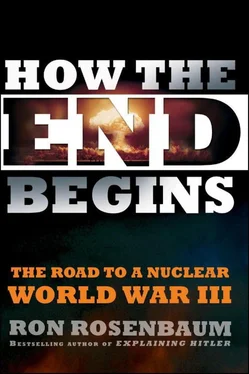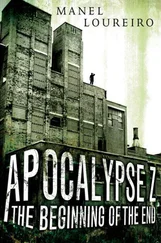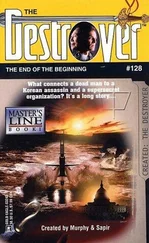“See this is because of bad writing. What it actually said was halted in 2003 was ‘clandestine conversion, enrichment, weapons design.’”
“Which meant they could continue dual use enrichment and ballistics and for all we know the weapons design program was already completed in 2003?”
“Yes.” [265]
The misreading of the NIE had serious consequences for the chance of an Israeli-Iranian war, as turns out. The New York Times has reported [266]that Israel’s efforts during the 2008–2009 period to obtain the weapons, refueling capacity, and permission to fly over Iraq for an attack on Iran grew out of its disbelief and anger at the 2007 NIE. The Israelis rebutted the American report as soon as it was released, and recurrently as new information developed in the years since the 2007 NIE, providing American intelligence officials and Admiral Mike Mullen, the chairman of the Joint Chiefs of Staff, with evidence that they said indicated the Iranians were still working on a weapon. And sure enough, the world eventually caught up to their assessment: in January 2009, the Wall Street Journal reported [267]there was fresh evidence of recent efforts by Iran to evade sanctions and acquire metals from China used in high-tech weaponry, including long-range missiles. That evidence came by way of the United Arab Emirates, which informed the U.S. in September 2009 that it had “intercepted a Chinese shipment headed to Iran of specialized aluminum sheets that can be used to make ballistic missiles. A month earlier, UAE officials had also intercepted an Iran-bound shipment of titanium sheets that could be used in long-range missiles,” according to the Wall Street Journal.
The Israelis were not the only ones highly critical of the United States report. Robert Gates, who was Bush’s secretary of defense and stayed on in that role to serve President Obama, said in 2009 that the 2007 NIE had presented the evidence poorly, underemphasizing the importance of Iran’s enrichment activity and overemphasizing the suspension of a weapons design effort that could easily be turned back on. In an interview, he said that in his whole career he had never seen “an NIE that had such an impact on U.S. diplomacy,” because “people figured, well, the military option is now off the table.” [268]What Gates was doing is drawing a straight line between the misleading NIE and a regional nuclear war involving Iran and Israel. It was Gates who, in late January 2010, was reported (first by The Guardian) to be suddenly rushing U.S. missile interceptor ships to the Persian Gulf ostensibly to reassure the Gulf sheikdoms, but in fact as almost everyone surmised to prevent an Israeli preemptive attack on Iran by providing them with a more credible nuclear umbrella.
He did not need to get deeper into how such a matter was perceived on the Israeli side, how much tighter it made their hair trigger.
The U.S. intelligence briefing about the case of the Enigmatic Box was one perspective on what “close” meant in terms of proximity to a regional nuclear war. But the question of what “close” means also arose during my discussion with a professional war gamer, Air Force Colonel (ret.) Sam Gardiner, who has participated in real-world war game exercises during the height of the Cold War and still teaches and practices simulations of nuclear war scenarios at the Army’s National War College in Washington, D.C. [269]I had sought him out because I wanted his expertise in tracing the branches of the decision trees that might have led from the Israeli raid on the Syrian nuclear facility to the global outbreak of nuclear war.
Gardiner is the human face of nuclear war gaming, perhaps the most high-profile human war gamer to be found. You could think of him as a doomsday film director, an auteur of Armageddon, doing remake after remake of endless variations on potential World Wars. How many long-range nuclear-armed subs, for instance, do we have and available on active duty—four according to Hans Kristensen of the Federation of American Scientists—ready for instant retaliation or preemption? How many megatons can they fire with what degree of accuracy at any given moment? (The number of nuclear warheads we have in total was finally divulged by the Obama Pentagon: 5,133 as of September 30, 2009. [270])
Gardiner uses computer-generated information to simulate reality. But his preferred technique is to bring living breathing fallible human beings to the table. Literally, to a large conference table, to explore what actual decision making in high-pressure nuclear war contexts might be like. The human factor where decisions are unpredictable, irrevocable, and consequences are ineradicable.
Gardiner gathers together military and diplomatic experts, supplies them with all the data they need, sets up imaginary but realistic prewar crisis scenarios, and gets them to role-play real-world decision makers—presidents, secretaries of defense and state, defense ministers of Russia, Iran, Israel, and other nations—to see how they would make their decisions, what factors in each crisis scenario would weigh most heavily, what the alternative decisions and alternative outcomes might be, depending on choices that can take place in war games often played in real time over the course of days or weeks.
There are of course academic treatises on deterrence and brinkmanship of the likes of Nuclear Deterrence and the Search for Credibility by mathematician Robert Powell, which employ immensely complicated equations of risk and probability. But it’s hard to believe real-time decisions will be made just by examining the array of solutions to such equations in the diminishing minutes or seconds that a president has to decide whether to launch.
What I didn’t realize about Gardiner until I spent some time talking with him was that he had played war games for real on the plains of Central Europe. Fresh out of the Air Force Academy he was assigned to SHAFE (Supreme Headquarters Allied Forces Europe) in Brussels in the 1970s where he found himself deeply enmeshed in the deployment of nuclear weapons in what was regarded as the most likely flashpoint of any U.S.–Soviet nuclear war.
What he found was a tangled web of nuclear command and control complexity due to several factors, which he says, have still not been sorted out. [271]
First the system of shared control of the nuclear trigger made everything more complex at SHAFE. [272]The nuclear weapons under SHAFE/NATO were mainly of U.S. origin and official ownership, but in order to get a release to fire a nuclear weapon or salvo from European territory a NATO commander had to have the unanimous consent of all sixteen NATO treaty members.
“I remember during one exercise,” Gardiner told me, “I ended up frantically trying to convince a Parisian telephone operator who didn’t speak English to put me through to SACEUR [Supreme Allied Command, Europe, which controlled the “safety catch” on all U.S.–origin nuclear weapons] to give me permission to fire a nuclear weapon.”
“Did you succeed?” I asked.
“What do you think?” he said.
“Have things improved? By now?”
“What do you think?” he said again, laughing, acknowledging that while public telephone switchboards were no longer required, the degree of difficulty, the number of complications had not diminished.
Another complicating factor—with serious relevance to the situation today—was that NATO had a “first use” policy, meaning it reserved to itself the right to use nuclear weapons should a conflict break out in Europe. [273]The initial reason for retaining first use dates back to the time the Soviet and Eastern European Warsaw Pact forces faced off against NATO divisions across the border between East and West Germany. For most of that time, the Soviets had NATO outmanned and outgunned with conventional forces and so most war games envisioned some kind of Warsaw Pact breakthrough that would lead its forces to overrun the rest of Europe all the way to the English Channel. They had to be deterred from such an attack by the possibility that NATO would use nuclear weapons. In most war games, this would result in a global nuclear war, presuming the Soviet Union then retaliated against NATO’s nukes with nuclear weapons of its own, leading to a U.S. attempt to take out all Soviet nukes. Gardiner believes that one of the first things a U.S. administration should do is push NATO to renounce its first use policy, which would have the effect of taking the Russians off their high-alert status and make both sides less vulnerable to accidental nuclear war.
Читать дальше











